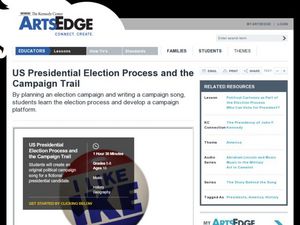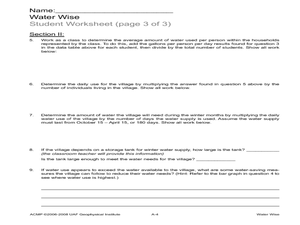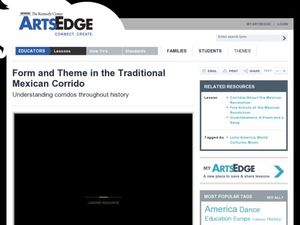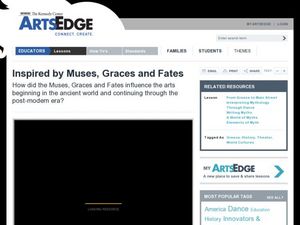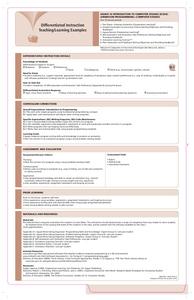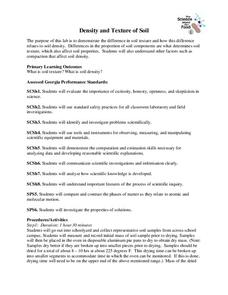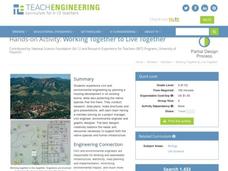Curated OER
US Presidential Election Process and the Campaign Trail
Students campaign for president. In this presidential election lesson, students discuss the process of electing presidents, write their own campaign songs, research a campaign train schedule, and create campaign maps.
Curated OER
Twain: Icon and Iconoclast
Students examine work by Mark Twain in the context of pre- and post-Civil War America. In this cross curricular lesson, students gather biographical information about Twain, use a Venn diagram to compare and contrast him with...
Curated OER
Planets in Balance
Students study the solar system by researching the planets. In this exploratory lesson students divide into teams and create mobiles.
Curated OER
Three Newport Mansions of the Gilded Age
Students visit the Newport Mansions. In this Gilded Age lesson, students explore the architecture and design of The Breakers, The Elms, and Marble House. Students create visual presentations that show the artistic features of the homes...
Curated OER
Water Wise
Students calculate their family's water consumption. In this water usage lesson, students discuss the water they use in their homes. Students complete the 'water wise' worksheets to tally their family's use of water. Students answer...
Curated OER
Was it a New Deal or a Raw Deal?
Students investigate the facets of the New Deal. In this Great Depression lesson, students research primary documents to explore the pros and cons of the New Deal legislation. Students respond to 1930's newspaper editorials...
Curated OER
Exploring Living Science Careers
Young scholars explore a variety of agricultural careers that are available and look into them in terms of the economics and suitability to their interests. In this agriculture careers lesson students research the agriculture...
Curated OER
How Much Energy is a Kilowatt Hour?
Young scholars study the conservation of energy. In this energy lesson students explain the differences between potential and kinetic energy.
Curated OER
It's All in the Translation
Students compare and contrast translations of Greek literature. In this dramatic literature lesson, students read and perform passages from four different translations of Euripides's Hecuba. Students discuss how the translations...
Curated OER
An Introduction to Shamanism
Students investigate Inuit customs. For this cultural traditions lesson, students read about religious customs of the Inuit including Shamanism. Students discuss the role of Shaman and create Inuktitut-English dictionaries with terms...
Curated OER
Form and Theme in the Traditional Mexican Corrido
Students examine the traditional Mexican musical form of corridos. In this cross curricular history and music lesson, students analyze the lyrics of popular corridos and the corridos' importance in Mexican culture. Students will...
Curated OER
Inspired by Muses, Graces and Fates
Students examine how artists express the Muses through the arts. In this art and history lesson, students work cooperatively to identify the Greek Muses, Graces and the Fates. Students will identify the attributes of each, participate in...
Curated OER
Twain: An American Humorist
Students examine American humor and character through analysis of works by Mark Twain. In this cross curricular lesson, students develop a definition of American humor and determine how and why some consider Twain the 'first truly...
Curated OER
Patterns Across Cultures: The Fibonacci Sequence in Visual Art
Young scholars study the origin of the Fibonacci Sequence. In this investigative lesson students identify works of art where Golden Spiral or Ratio appear.
Curated OER
Weather and Wind
Students study wind and its effect on weather. In this investigative lesson students write a report on wind and weather and create a movement sequence.
Curated OER
The Progressive Era: Muckrakers Grade 8
As you explore an excerpt from Upton Sinclair's The Jungle with your class, discuss how his descriptions of the meat-packing industry caught the public's attention and helped to promote change in the Progressive Era.
EduGAINs
Introduction to Solving Linear Systems
Word problems offer class members an opportunity to learn the concept of solving linear systems using graphs. Individuals choose a problem based upon preferences, break into groups to discuss solution methods and whether there...
Ontario
Animation Programming—Computer Studies
Introduce high schoolers interested in animation programming to fundamental programming concepts so that they can plan and write simple programs.
Cornell University
Constructing and Visualizing Topographic Profiles
Militaries throughout history have used topography information to plan strategies, yet many pupils today don't understand it. Scholars use Legos and a contour gauge to understand how to construct and visualize topographic profiles. This...
University of Georgia
Density and Texture of Soil
All soil is not created equal! A lab activity asks learners to collect and analyze soil. Specific calculations determine the amount of sand, silt, and clay in a sample and allow individuals to identify the soil texture.
Childnet International
Responding to Cyberbullying
After watching a short video about cyberbullying, individuals play an online cyberbullying game and then create their own Digizen that expresses their values and presents their vision for themselves, their friends, and the world at large.
Teach Engineering
Working Together to Live Together
Whose home is it anyway? Design teams plan a housing development in which they must also protect a native species. The teams consist of a project manager, civil engineer, environmental engineer, and graphic designer. Teams present their...
Beyond Benign
Green"er" Precipitation Reaction
All sodium carbonate may not have the same amount of carbonate, but it should have the same percent. Learners write and balance an equation to predict the chemical reaction between sodium carbonate and zinc acetate. Through the lab...
NASA
A Different Perspective
What can we learn from the data? Young scholars analyze actual solar data to answer specific questions. The activity presents an opportunity for an open-ended investigation of the data to conclude a five-part series on solar winds.
